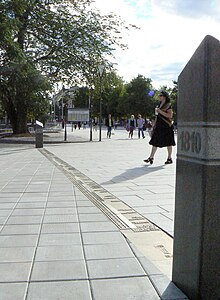Timeline
A timeline (also time table or timeline ) is a representation of time periods and sequences of temporal events in the form of a graph or table . The time sequence is shown as a spatial sequence, e.g. B. earlier events are higher up and later events further down. In addition to the order ( ordinal scale ), there is also the option of displaying time intervals using spatial distances ( interval scale ) : the greater the distance between two points on the bar, the greater the time interval between the corresponding events.
General

The term “timeline” or “timeline” is mostly used to describe a graphical representation of the course of time in the form of a straight line, in which individual events are entered through markings crossing the straight line, like a number line. Periods such as B. an epoch are then displayed as sections between two such events and highlighted in color if necessary. In addition, this form of representation offers space to add further text or illustrations to the events or periods. It is also possible to display different timelines one above the other or next to one another. In this way, different developments can be juxtaposed that took place during the same time. An example of such a synoptic representation is Arno Peters ' "Synchronous Optical World History" . There events from all parts of the world and all areas of life are ordered synchronously in a timeline.
Artistically designed timelines can also be found on the facades of historical buildings. Such elaborately designed illustrations of historical events are also known as history friezes.
Time tables, on the other hand, are mostly presentations in the form of a table, which, similar to a tabular curriculum vitae, list dates or periods in chronological order and, if necessary, provide additional information in a further column. Time tables usually start with the earliest date. However, it can also be useful to show the chronological sequence in reverse, starting with the latest date. Chronological tables were first used by the Encyclopedia Britannica as a means of showing individual subjects in their historical development. A chronology usually sorts according to years or time segments. Periods of the same length are not necessarily filled with the same amount of information or text. The chronicle has a somewhat similar task , often summarizing periods from a systematic point of view, but presenting historical events in much more detail and usually in prose form. However, the chronicle can also be strictly divided into equal periods of time.
In nature, too, there are easily readable representations of chronological sequences, for example in the layering of sedimentary rocks or in the annual rings of trees. In a sense, these represent natural timelines.
Example of a horizontal timeline
The example builds on the list of Old Norse languages .
Periodization of North Germanic:

Example of a vertical timeline
The list of governing mayors of Berlin is used for the example of a vertical timeline .

|
The governing mayors of West Berlin from 1948 until today:
- Ernst Reuter ( SPD ) (December 7, 1948 to September 29, 1953)
- Walther Schreiber ( CDU ) (October 22, 1953 to January 11, 1955)
- Otto Suhr ( SPD ) (January 11, 1955 to August 30, 1957)
- Franz Amrehn ( CDU ) (August 30 to October 3, 1957) provisionally
- Willy Brandt ( SPD ) (October 3, 1957 to December 1, 1966)
- Heinrich Albertz ( SPD ) (December 1, 1966 to October 19, 1967)
- Klaus Schütz ( SPD ) (October 19, 1967 to May 2, 1977)
- Dietrich Stobbe ( SPD ) (May 2, 1977 to January 23, 1981)
- Hans-Jochen Vogel ( SPD ) (January 23 to June 11, 1981)
- Richard von Weizsäcker ( CDU ) (June 11, 1981 to February 9, 1984)
- Eberhard Diepgen ( CDU ) (February 9, 1984 to March 16, 1989)
- Walter Momper ( SPD ) (March 16, 1989 to January 24, 1991)
- Eberhard Diepgen ( CDU ) (January 24, 1991 to June 16, 2001)
- Klaus Wowereit ( SPD ) (June 16, 2001 to December 11, 2014)
- Michael Müller ( SPD ) (December 11, 2014 to date)
See also
Web links
- Create interactive timelines, timelines or timelines for the web with open source tools or free software
- Digital timelines - Open Educational Resources (examples) ( Memento from May 4, 2015 in the Internet Archive ) and instructions for creating a digital timeline as an OER using TimelineJS
- Vistorica : Website on which history is visualized in the form of automatically generated timelines and maps
- WikiTimeLine
- The timeline Automatically generated timelines of breaking news articles
- Timeline Epochs of History (History Didactic Blog, University of Cologne)
- Timeline: All important epochs and events of history on 5 boards ("ZeittafelGeschichte", (PDF; 296 kB) Lehrer-Online, Bonn) (PDF, 289 KiB)
- Timelines as a means in history lessons, Historical Institute of the University of Giessen ( Memento from March 13, 2014 in the Internet Archive )
- Telepolis on the new edition of "Synchronous Optical World History"
- German site for the open source program "Timeline" (Linux, Windows, Mac OS X)
Individual evidence
- ↑ a b c Michael Sauer : The timeline. In: Hans-Jürgen Pandel / Gerhard Schneider (ed.): Handbook of media in history lessons. 3rd edition Schwalbach / Ts. 2005, pp. 197-210.
